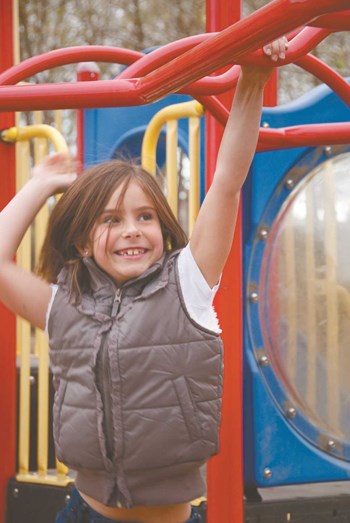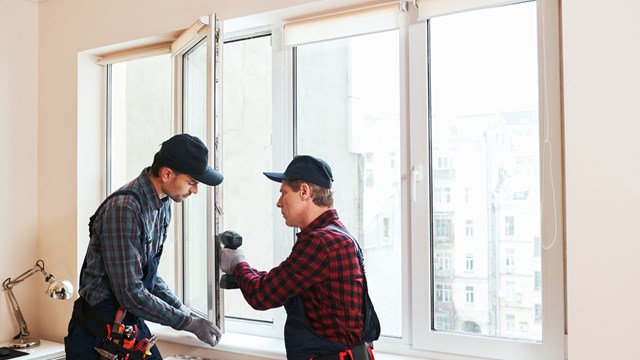
According to a study released in January of this year by the Kaiser Family Foundation, kids today are plugged in. Aside from the time they spend in class at school and asleep in bed, children between the ages of eight and 18 spend more than 7 and a half hours a day interacting with smart phones, computers, television, or other electronic gadgets.
In such a wired culture, playgrounds may seem like a quaint anachronism. After all, who wants to mess around with swings and slides when Call of Duty IV just came out for the Xbox 360, or when there are Facebook status updates and Twitter feeds to maintain?
But while the playground isn't perhaps the all-important backdrop it used to be in kids' lives, the importance of active, outdoor play in childhood social development and overall physical health remains—and a safe, modern, well-kept playground can be a terrific amenity for HOAs. Play equipment today is very different from what most of us grew up with—it's safer, for one, with more engaging, interactive features and fewer sharp-edged, white-hot metal slides—but as with any amenity, maintaining a playground also means accepting certain risks and responsibilities.
Tetherball is So... 1950
The state of New Jersey defines a playground as "an improved area not intended for use as an athletic playing field or athletic court designed, equipped and set aside for play of six or more children, which is and shall include any play equipment, surfacing, fencing, signs, internal pathways, internal land forms, vegetation and internal structures."
Play areas being a sense of community to an association. In addition to providing a space for kids to exercise and interact with each other, they serve as a place where parents and caregivers can meet and socialize while the kids play. A well-designed, well-maintained play area is an amenity that boosts value in both concrete and intangible ways.
And according to industry pros, it's important to realize that play equipment has come a very long way since the dark days of asphalt and rusty swing-sets. Every year, the playground industry introduces new and updated products to the market that allow children to twist and turn through tunnels, climb rock walls, make their way over shaky bridges, push buttons, pull levers, and much more. Today's equipment is inspired more by activities like rock climbing and skateboarding than the old standbys like tag and hopscotch.
According to Kevin Cook, director of sales and marketing with Playworld Systems in Lewisburg, Pennsylvania, associations with enough acreage and funding can even create full parks. "This includes skate parks, rock climbing areas, climbing boulders, life trails for everyone that augments the walking experience," he says. "You can create a play area for all ages, everyone and their interests." And play areas can be customized to reflect just about any theme or fantasy an association can dream up. "Let's say your association name is 'Mallard Point,'" Cook continues. "We can create custom graphics—even a pond scene—and customize the entire structure to your theme."
Indeed, says Cook, what type of play area your HOA has is really only limited to your imagination—and your budget.
Safety First and Foremost
Before the first slide is slid or the first swing is swung however, there's a lot of planning to do, much of which revolves around keeping the kids using your play area as safe as possible. Playground-related mishaps are responsible for hundreds of emergency room visits every year, and while it may be impossible to eliminate every danger, any play equipment on your association's grounds must be vetted for safety, properly insured, and in compliance with safety codes.
A long list of regulations govern New Jersey's playgrounds, covering construction, maintenance and liability issues. "Playgrounds are expanding," says Scott Wolfson, a spokesman for the Consumer Product Safety Commission (CPSC). "As playsets get taller and bigger, new safety concerns need to be addressed."
The CPSC is actually good place to start if your HOA is unsure of where to begin with the initial stages of planning or upgrading your play equipment. Wolfson says that examining playgrounds and their various components is something his office takes very seriously, due to the potential safety risk play equipment represents. While the CPSC doesn't do playground inspections per se, Wolfson's office literally wrote the book when it comes to safety guidelines for playgrounds; the CPSC's Handbook for Public Playground Safety is required reading for anyone training to be a playground inspector, but can be obtained by any individual or group interested in maintaining a safe space for kids to play.
In order to reduce New Jersey's number of playground-related accidents, regulations and codes are continually being proposed, implemented, and revised by lawmakers. The state, the Department of Community Affairs (DCA), and the CPSC have all joined together to draft specific standards of care that HOAs and municipalities must follow when building or upgrading their playgrounds. Not every one of the guidelines set by these agencies is actual law, but by adhering to the guidelines, associations can avoid potential hazards and reduce their exposure to liability.
A key part of compliance is installing well-built, code-compliant equipment from reputable manufacturers, says George Herberger, CPSI, vice president of Ben Shaffer & Associates, Inc., a New Jersey design and supply company of playground equipment. "You can't just go to Home Depot or a store off the highway and purchase backyard playsets," says Herberger, a certified playground safety inspector. "You should always deal with a credible, factory-certified representative who's going to do everything by the letter of the law."
Herberger goes on to say that while it may be tempting to save money by making equipment decisions on your own, in the long run such decisions most likely won't be cost effective. Codes dictate specific rules for equipment, such as a minimum space allowances between planks and other surfaces, guidelines for anchoring other items, such as climbing ropes, and so forth. These and other details of equipment guidelines are detailed in the CPSC's handbook, but it's not necessarily stuff that the average HOA board member or manager would know.
"As designers, we have to know all of those codes and design accordingly," Herberger explains. "Now the American Society for Testing and Materials (ASTM) has their own guideline for playground equipment as well, and we use both to design our equipment."
Taking Responsibility
But while it may be a play equipment specialist's job to know the minutiae of safety rules governing his or her products, Herberger stresses that associations bear the responsibility as well. "To reduce their liability, [boards and managers] need to make sure that the equipment they have meets the guidelines," he says, "and an easy way to do that is to look for an IPEMA certification, which is a third-party testing organization that certifies that equipment meets both the CPSC and the ASTM guidelines."
According to the DCA's office of Communications and Policy, "it is ultimately the responsibility of the property owner to ensure compliance with code." If your association residents believe, though, that the equipment is faulty or hazardous, they should notify management immediately and take steps to rectify the problem.
Along with managing and maintaining their playground facilities for the safety of the kids using them, HOAs must also take insurance and liability issues into consideration—both for the sake of their residents and for their own bottom line. It's not enough to just hang a sign disclaiming any responsibility for personal loss or injury incurred on your association's play equipment—having the appropriate insurance coverage is crucial.
According to Brown & Brown, a community association insurance company with offices in Bethlehem, Pennsylvania, insuring a playground isn't an issue as long as older, more dangerous aluminum material isn't involved and there is plenty of safety-rated ground cover. Newer playgrounds should be code-compliant and safe.
For his part, Wolfson also recommends working with a professional. "Have a certified inspector come in with CPSC's handbook in hand and measure the depth of your ground coverage, check to see if bolts are recessed into the wood, and go over the various measurements we have for swings and other components," he says. "They should also make sure the different areas of the playground are in fact appropriate for the different age groups they're intended for."
"Boards first need to inspect their existing equipment," adds Herberger. "Then, if they go forward and purchase something, they need to make sure it's IPEMA certified. After that, a regular program of maintenance is important." He says that means that every morning, before children are even allowed onto the playground, a competent HOA staff member should check to ensure that the safety surfacing is in place, no concrete footings have been exposed, everything is tight on the structure, and that nothing has been broken or vandalized overnight.
Do-It-Yourself?
In order to reduce costs and encourage community involvement, some associations turn a playground build or upgrade project into a community-wide activity, inviting everyone to turn out and lend a hand installing new equipment or sprucing up existing elements.
"We do about 100 community builds per year where an HOA will participate and we supervise," says one playground designer based in Missouri. "This provides a community feel, and lowers the cost of installation."
It can also be a lot of fun," he continues, "but again, it's ill-advised for an association to launch a project like that without professional guidance. Some associations won't do these builds because they don't want the liability with the installation. If something happens and we did the build, the liability is with us."
If an HOA wants to put some sweat equity into their playground, many manufacturers and designers will be more than happy to oversee the assembly process to insure that things are put together properly and in compliance with safety guidelines. And regardless of whether the manufacturer or HOA residents do the build, says the playground designer, all manufacturers do safety checks after equipment is installed. If there is a problem, the seller can be called in to fix the problem.
According to Cook, after safety and liability are covered, perhaps the most important thing to remember about purchasing playground equipment is, "Play is about more than running around. It's about wellness, whole body fitness, socialization and emotional wellness, and play provides an environment for unstructured learning. Play is for all ages and it's about fun."
Hannah Fons is associate editor of The New Jersey Cooperator. Additional research by Mary Fons-Misetic.






Leave a Comment